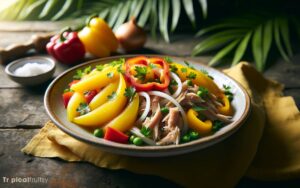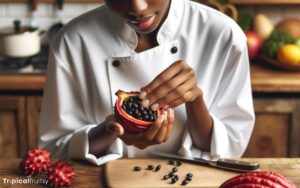What Does Ackee Taste Like? Explained!
Ackee, a fruit originating from West Africa and a staple in Jamaican cuisine, has a flavor that is often described as rich, buttery, and slightly nutty, akin to hearts of palm.
When ripe, its creamy texture and mild taste make it an excellent base for absorbing seasonings, particularly in its traditional dish, ackee and saltfish.
Ackee’s taste is unique and not easily compared to other fruits. It’s important to only consume ackee when fully ripe and properly prepared, as unripe ackee contains toxic substances.
Delve into the buttery delight of ackee and discover why it’s the heart of Jamaica’s culinary heritage.

Key Takeaway
Culinary and Botanical Characteristics of Ackee: West Africa to Jamaican Cuisine
| Aspect | Description |
|---|---|
| Origin | West Africa |
| Popular in | Jamaican cuisine |
| Flavor | Buttery, slightly nutty |
| Comparable To | Hearts of palm |
| Texture | Creamy, delicate |
| Toxicity | Present in unripe fruit; safe when ripe and prepared |
| Culinary Applications | Typically boiled or sautéed, paired with salted fish |
The Origin of Ackee

Originating in West Africa, ackee is now most commonly associated with Jamaican cuisine where it has become a national staple.
The fruit was brought to Jamaica from West Africa in the 18th century, presumably on slave ships, and has since ingratiated itself into the fabric of Jamaican culture and gastronomy.
Ackee’s journey is not just a tale of geographical transplantation but also one of culinary assimilation and identity formation.
Its peculiar presence in local dishes underscores the complexity of cultural exchanges that have shaped regional food profiles.
In Jamaica, ackee has transcended its African roots, evolving into a symbol of Jamaican heritage and pride, particularly when paired with saltfish, creating a dish emblematic of the island’s resourcefulness and rich culinary diversity.
Ackee’s Texture Profile

The texture of ackee is uniquely creamy, often compared to that of scrambled eggs, providing a delicate yet distinct mouthfeel.
When ripe and properly cooked, the flesh of the ackee becomes soft and buttery, melting away effortlessly on the palate.
This succulent texture is one of ackee’s most celebrated characteristics, allowing it to blend seamlessly into dishes, complementing rather than overpowering accompanying flavors.
To further elucidate this characteristic, consider the following table:
| Aspect | Description |
|---|---|
| Firmness | Yielding, not tough or chewy. |
| Consistency | Homogeneous, without fibres or graininess. |
| Comparison | Similar to well-cooked scrambled eggs. |
| Mouthfeel | Creamy, rich, and melts in the mouth. |
An appreciation of ackee’s texture is essential for those seeking a comprehensive understanding of this exotic fruit’s culinary profile.
Flavor Components Explained
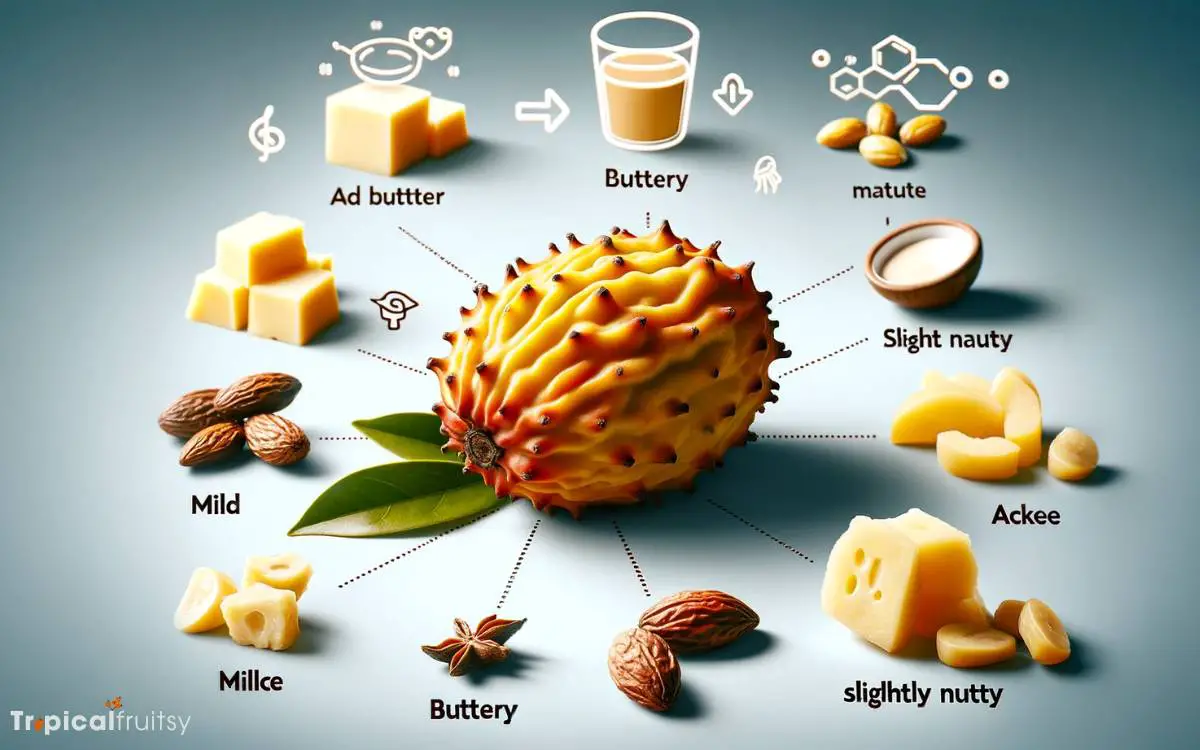
Several distinct flavor components characterize the taste profile of ackee, ranging from subtly sweet to mildly nutty with a faint hint of bitterness.
When dissecting the fruit’s complex flavor, one might first notice a creamy, buttery essence, often compared to hearts of palm or a milder form of avocado.
This initial taste gives way to understated sweet notes reminiscent of freshly shelled peas, which is an unexpected contrast to the savory qualities of the fruit.
As the palate adjusts, there is an emergence of a slightly bitter undertone, akin to the gentle tannins found in certain nuts.
Ackee’s unique taste is further nuanced by its interaction with other ingredients, often absorbing and melding with spices and seasonings, making it a versatile component in culinary applications.
Preparing and Cooking Ackee

The culinary journey of ackee begins with the crucial step of selecting perfectly ripe fruit, a process that demands a discerning eye as premature or overripe ackee can greatly affect both flavor and safety.
Mastering the art of cooking ackee involves understanding and applying specific techniques that enhance its unique taste while ensuring its delicate texture is preserved.
Moreover, it is imperative to adhere to safety tips to mitigate the potential risks associated with improper preparation of this traditional Jamaican ingredient.
Selecting Ripe Ackee
Understanding how to select a ripe ackee is essential for experiencing its unique flavor and ensuring safety during preparation and cooking.
The fruit’s readiness is not only about peak taste but also about reducing the risk of toxicity, as unripe ackee contains harmful substances.
Selecting a ripe ackee involves:
- Observing the pods, which should naturally open on the tree, revealing black seeds and bright yellow flesh.
- Feeling the firmness; ripe ackee will yield slightly under pressure, indicating a creamy texture inside.
- Ensuring there is no red tissue attached to the arils, as this can be toxic.
- Smelling the fruit; a subtle, nutty aroma can hint at maturity and potential richness in flavor.
Cooking Techniques
How does one transform ripe ackee into a culinary delight? The process begins with the selection of fruit that has naturally opened, revealing its ready-to-eat status.
Once the edible portions are extracted, the cooking techniques employed can enhance or diminish the subtle, buttery flavor and creamy texture that make ackee a unique ingredient.
| Technique | Description |
|---|---|
| Boiling | Removes potential toxins and softens the ackee. |
| Sautéing | Pairs with aromatics to heighten the dish’s flavor. |
| Baking | Integrates ackee into quiches or pastries. |
| Blending | Creates smooth ackee spreads or dips. |
Analyzing and describing these methods reveals that each technique serves a purpose in achieving the desired consistency and taste profile.
Subjectively, the most popular method is sautéing, often with onions and peppers, as it creates a symphony of flavors that celebrate the fruit’s versatility. This culinary journey, while rich in flavor, also necessitates attention to safety measures.
Safety Tips
While exploring the culinary potential of ackee, it is imperative to adhere to safety guidelines to prevent the risk of foodborne illness.
Ackee, when improperly prepared, can lead to ‘Jamaican Vomiting Sickness,’ caused by the toxin hypoglycin A. Thus, understanding proper preparation techniques is not only crucial for taste but also for your health.
Here are four essential safety tips:
- Wait for the fruit to naturally open: The ackee must be fully ripe and open naturally on the tree to ensure lower toxin levels.
- Remove the seeds and membrane: Only the fleshy yellow arils are edible; the black seeds and pink membranes are toxic.
- Boil the ackee arils: Boiling helps to reduce the presence of toxins.
- Discard the water: Always throw away the water used to boil the ackee to eliminate any leached toxins.
With these precautions in mind, one can safely enjoy the rich flavors of ackee, such as in the beloved ackee and saltfish dish.
Common Ackee Dish: Ackee and Saltfish
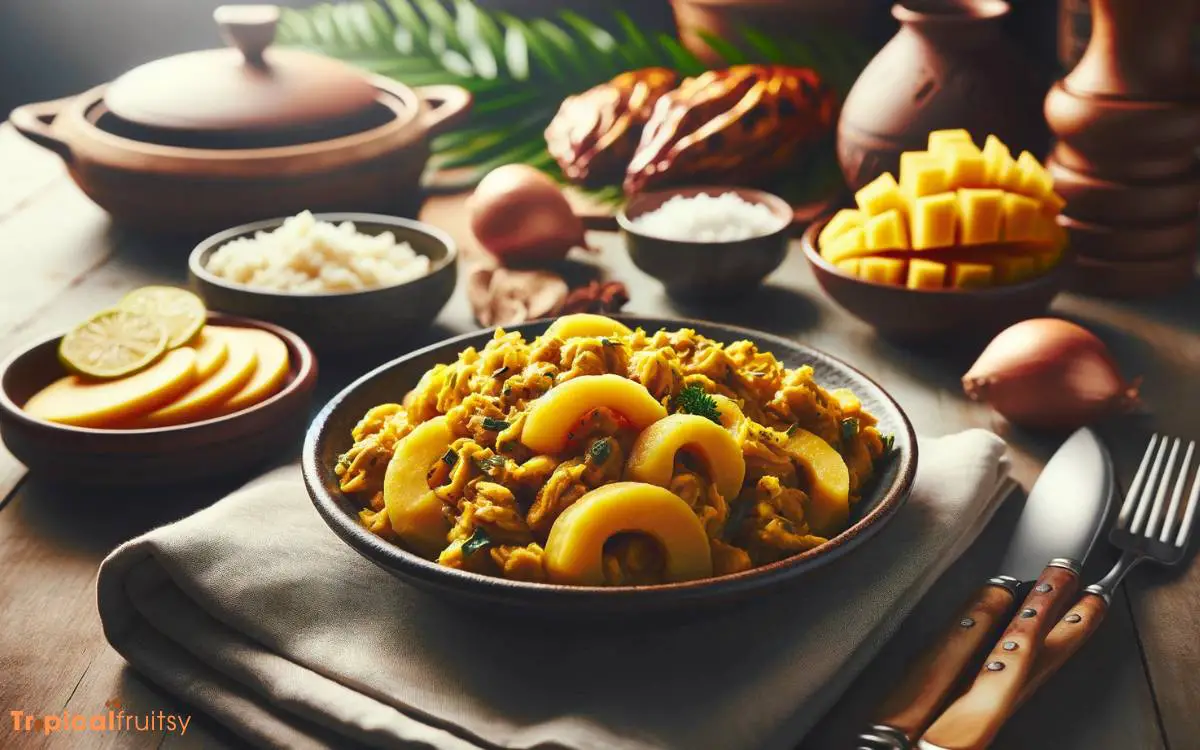
Ackee and Saltfish, a traditional Jamaican dish, artfully combines the creamy texture of ackee with the savory flavor of salted codfish.
This dish, deeply embedded in Jamaican culture, presents a harmonious blend of textures and flavors that is both comforting and exhilarating.
The ackee, with its subtle, buttery flavor, contrasts the robust, briny taste of the saltfish, creating a culinary tapestry that is as complex as it is delightful.
| Ingredient | Role in Dish | Culinary Significance |
|---|---|---|
| Ackee | Provides creamy texture | National fruit of Jamaica |
| Saltfish | Offers savory flavor | Preserved cod, a protein staple |
| Scotch Bonnet | Adds a spicy kick | Symbolic of Caribbean heat |
| Onion & Garlic | Build aromatic foundation | Essential for depth of flavor |
| Thyme | Enhances with earthy notes | Traditional herb in Caribbean |
The dish’s nuanced palate is a testament to the rich tapestry of Jamaican cuisine, offering a taste that is as vibrant and spirited as the island’s culture.
Health Benefits and Risks

One must consider both the nutritional advantages and potential hazards when incorporating ackee into their diet.
This exotic fruit offers a unique combination of flavors and textures, but its impact on health is multifaceted.
- Rich in Essential Fatty Acids: Ackee is a rare source of beneficial fatty acids, which can support heart health and cognitive functions.
- Vitamin Powerhouse: It boasts high levels of vitamins A, C, and B complex, fostering overall wellness and immune resilience.
- Hypoglycin A Toxin: Unripe ackee fruit contains dangerous levels of this toxin, which can lead to severe illness or even death.
- Cultural Significance: For many, the health risks are mitigated by traditional preparation methods that ensure safety, making ackee a nourishing staple in their diet.
Understanding these aspects is crucial for those seeking to enjoy ackee responsibly.
Pairing Ackee With Other Foods
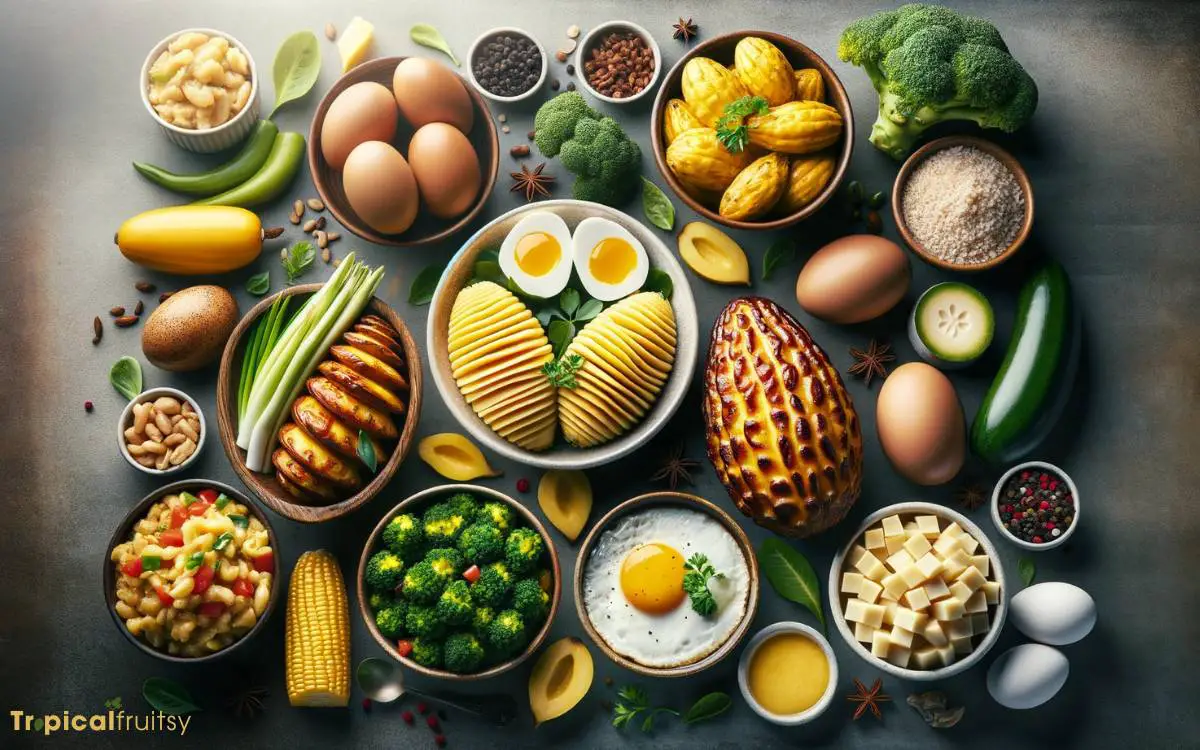
The fruit’s distinct flavor profile makes ackee an ideal complement to a variety of ingredients, from savory meats to aromatic spices.
Its subtle, buttery taste and soft, delicate texture create a unique palate experience that pairs exceptionally with the bold flavors of smoked fish or salted meats.
Ackee’s gentle creaminess is often the perfect foil for the fiery piquancy of Scotch bonnet peppers, a staple in Caribbean cuisine.
When harmonized with the nuanced sweetness of onions and the earthy tones of garlic and thyme, the fruit’s flavor is enhanced, producing a dish that is richly layered and satisfying.
Additionally, ackee can serve as a substitute for eggs in vegetarian dishes, bringing a depth of flavor and heartiness to the plate.
Where to Find and Buy Ackee

For those intrigued by ackee’s unique flavor, the fruit can be purchased in canned form at international markets and specialty Caribbean stores, or fresh at local markets in tropical regions where it is indigenous.
- International Markets: The multicultural shelves brim with the possibility of culinary adventure, offering canned ackee amid a tapestry of global delicacies.
- Specialty Caribbean Stores: These niche boutiques are treasure troves of Caribbean culture, with the vibrant, buttery cans of ackee promising a taste of the islands.
- Online Retailers: With a click, one can summon the spirit of Jamaica to their doorstep, the cans of ackee a gateway to exotic cuisine.
- Local Markets in Tropical Regions: Here, the fresh, hearty ackee pods sit, an emblem of nature’s generosity, waiting to be transformed into a sumptuous dish.
Each of these locales offers a unique gateway to experiencing the rich and subtle flavors of ackee, catering to the curiosity of the gastronomically adventurous.
Cultural Significance in Jamaica
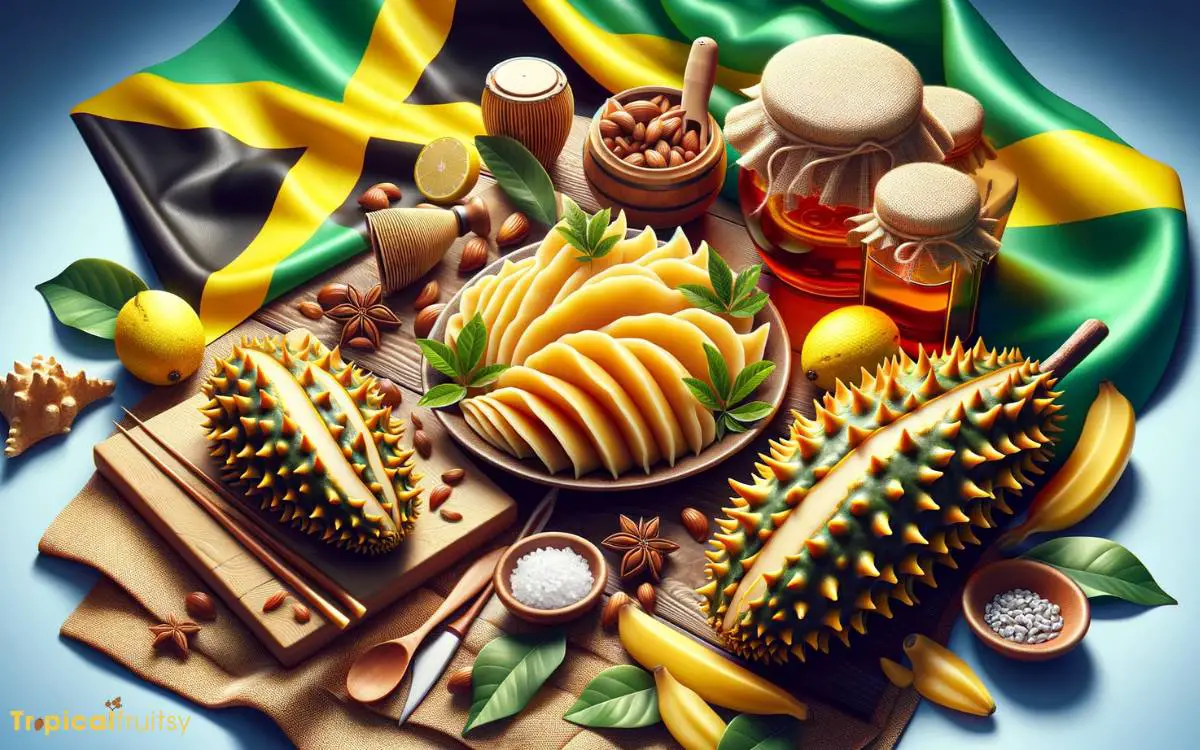
Ackee holds a revered place in Jamaican culture, serving as the national fruit and a staple ingredient in the island’s beloved national dish, ackee and saltfish. This dish is more than a mere culinary delight; it is a symbol of the island’s history and resilience.
The fruit’s journey to the heart of Jamaican cuisine is a tale of cultural amalgamation, reflecting the island’s complex past.
| Aspect | Description | Significance |
|---|---|---|
| Historical | Brought from West Africa in the 18th century | Symbol of heritage |
| Culinary | Key ingredient in national dish | Reflection of national pride |
| Socioeconomic | Cultivated across the island, source of livelihood | Economic importance |
The ackee’s rich buttery flavor, paired with the salty, savory notes of saltfish, creates a dish that is deeply embedded in the fabric of Jamaican society, evoking a sense of home and unity among its people.
-Is It Safe to Eat Ackee Despite Its Poisonous Parts?
Despite the potential dangers, the ripe part of ackee poison is actually safe to eat. It’s important to only consume the fruit once the pods have naturally opened on the tree, indicating that the toxic parts have dissipated. Properly preparing and cooking the ackee also helps to ensure it is safe for consumption.
What Does Ackee and Saltfish Taste Like
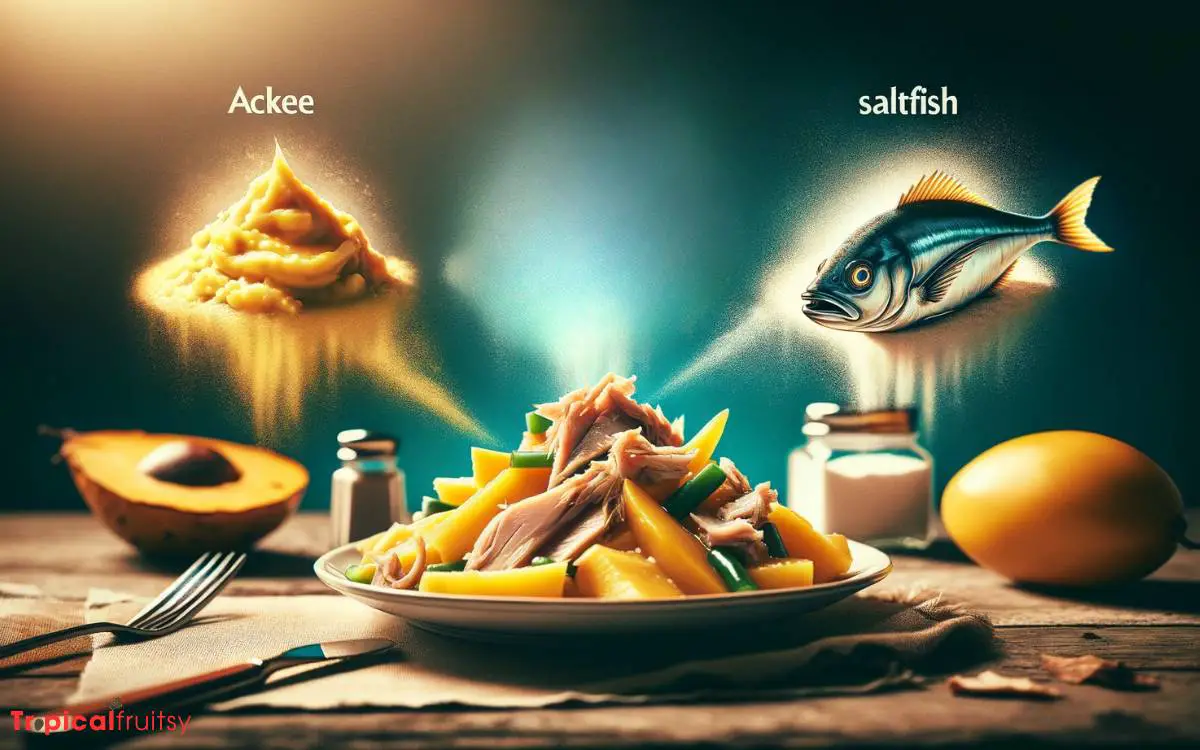
Ackee and saltfish, a traditional Jamaican dish, is renowned for its unique and flavorful taste profile. It combines the mild, nutty, and slightly sweet taste of ackee with the salty, rich flavor of saltfish (salted cod).
Here’s a breakdown of its taste and texture:
Flavor Profile
- Ackee: This fruit has a delicate, buttery flavor, often compared to hearts of palm, avocados, or scrambled eggs. It doesn’t have a strong taste on its own but absorbs the flavors of the ingredients it’s cooked with.
- Saltfish: Salted cod offers a distinct salty, savory flavor. It’s robust and can be slightly fishy, but soaking and boiling it before cooking reduces its saltiness and mellows its taste.
- Spices and Seasonings: The dish is typically cooked with aromatic ingredients like onions, garlic, scallions (green onions), thyme, and Scotch bonnet peppers. These add layers of sweetness, herbaceous notes, and a hint of heat.
- Texture: Ackee has a creamy, soft texture that gently contrasts with the flakiness of the rehydrated saltfish. The overall mouthfeel is somewhat similar to a hearty, rich stew, with the ackee providing a smooth counterbalance to the fish.
Culinary Experience
- Balanced Flavors: The dish is a harmonious blend of flavors. The saltiness of the fish complements the mild, creamy ackee, while the spices and seasonings add depth and complexity.
- Versatility: Ackee and saltfish can be enjoyed in various ways, including as a breakfast dish, main meal, or side dish. It’s often served with breadfruit, hard dough bread, dumplings, or fried plantains, which add additional sweet or savory notes and varying textures.
- Cultural Significance: As Jamaica’s national dish, ackee and saltfish holds a special place in the heart of Jamaican cuisine, representing a fusion of flavors that reflect the island’s history and cultural diversity.
For those unfamiliar with Caribbean cuisine, ackee and saltfish might seem like an unusual combination at first.
However, its rich, savory flavors combined with the creamy texture of ackee make it a dish that many find surprisingly delightful and satisfying.
Conclusion
Ackee emerges as a culinary chameleon, adapting its subtle flavors to complement various ingredients.
This fruit, much like a skilled orchestra conductor, harmonizes the symphony of flavors in dishes such as the iconic ackee and saltfish.
Its unique texture and taste enhance the gastronomic tapestry of the Caribbean. Ackee’s nutritional benefits are tempered by its potential risks, underscoring the importance of knowledgeable preparation.
This fruit remains a cultural cornerstone and a testament to Jamaica’s rich culinary heritage.

